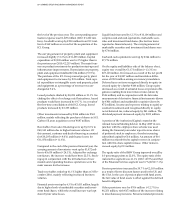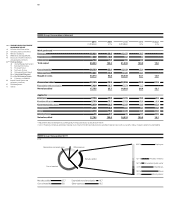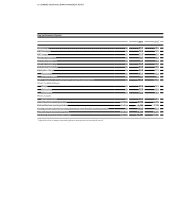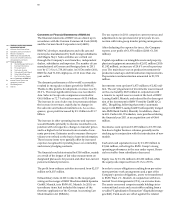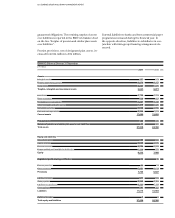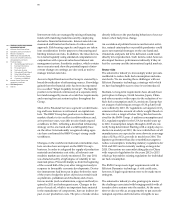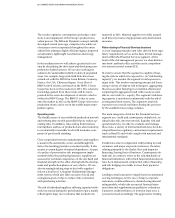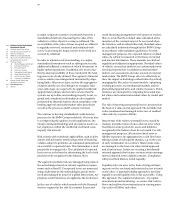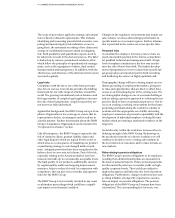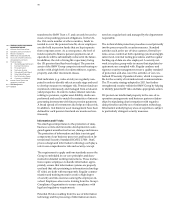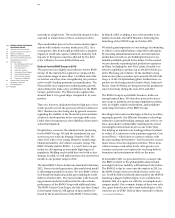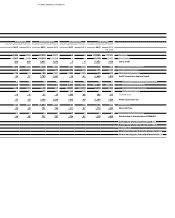BMW 2011 Annual Report Download - page 67
Download and view the complete annual report
Please find page 67 of the 2011 BMW annual report below. You can navigate through the pages in the report by either clicking on the pages listed below, or by using the keyword search tool below to find specific information within the annual report.67 COMBINED GROUP AND COMPANY MANAGEMENT REPORT
Risk management in the BMW Group
As a globally operating organisation, the BMW Group
is exposed to a variety of risks, arising in part from the
increasing internationalisation of business activities and
ever-greater competition. Consciously taking calculated
risks and making full use of the opportunities relating
to them is the basis for corporate success. A description
of business opportunities is provided in the section
“Outlook for the BMW Group in 2012”.
Having a system of ongoing risk management proce-
dures in place is a prerequisite for assessing at an early
stage the impact of changes in the legal, economic or
regulatory environment or within the enterprise. Risk
management within the BMW Group is an integral part
of our business processes and organisational structures.
Although managed from the centre, the risk manage-
ment system is based on a decentralised structure, sup-
ported by a network of risk managers. This approach
raises awareness and encourages a balanced approach
to risks at all levels throughout the organisation. The risk
management system is tested regularly for appropriate-
ness and effectiveness by Internal Audit. Knowledge
gained from these audits serves as the basis for further
improvements.
The risk management process, which is applied through-
out the BMW Group, comprises the early identification
and analysis of opportunities and risks, their measure-
ment,
the coordinated use of suitable management tools
and risk management monitoring. As part of the risk re-
porting
system, decision-makers are regularly informed
regarding risks which could have a significant impact
on business. Decisions are reached after consideration
of detailed project analyses that show both potential
risks and potential opportunities. In conjunction with
the Group’s monthly and long-term forecasting sys-
tems, opportunities and risks attached to specific busi-
ness activities are evaluated and used as the basis for
implementing measures to mitigate risks and achieve
targets. Important success factors are monitored con-
tinuously to ensure that unfavourable developments are
identified at an early stage and appropriate counter-
measures
implemented.
Standardised rules and procedures consistently applied
throughout the BMW Group form the basis for an
or-
ganisation that is permanently learning. By regularly
sharing experiences with other companies, the BMW
Group ensures that new insights flow into the risk man-
agement system, thus ensuring continual improvement.
Regular basic and further training as well as informa-
tion events are invaluable ways of preparing people for
new or additional requirements with regard to the pro-
cesses in which they are involved.
The main aspects of risk management activities are de-
scribed below. Additional comments on risks in con-
junction with financial instruments are provided in the
notes to the Group Financial Statements.
Risks relating to the general economic environment
The year under report saw a variety of contrasting eco-
nomic developments. The global economic upward
trend continued in most respects during the first half
of
the year, despite the consequences of the earthquake
in Japan and political unrest in the Middle East. Since the
start of the third quarter 2011, it has been the sovereign
debt crisis – particularly in Europe – that has emerged as
the main issue affecting international financial markets.
Against this background, the world’s car markets have
performed extremely well, with most of the momentum
coming once again from growth markets.
The sale of vehicles outside the euro zone gives rise to ex-
change
risks. Three currencies (the Chinese renminbi,
the US dollar and the British pound) accounted for ap-
proximately two-thirds of the BMW Group’s foreign cur-
rency exposures in 2011. We employ cash-flow-at-risk
models and scenario analyses to measure exchange rate
risks. These tools provide information which serves
as the basis for decision-making in the area of currency
management.
We manage currency risks both at a strategic (medium
and long term) and at an operating level (short and me-
dium term). In the medium and long term, foreign ex-
change risks are managed by "natural hedging", in other
words by increasing the volume of purchases
denomi-
nated in foreign currency or increasing the volume of
local production. In this context, the expansion of the
plant in Spartanburg, USA, and the new plant under
construction in Tiexi* at the Shenyang site in China are
helping to reduce foreign exchange risks in two major
sales markets. For operating purposes (short and me-
dium term), currency risks are hedged on the financial
markets. Hedging transactions are entered into only
with financial partners of good credit standing. Coun-
terparty risk management procedures are carried out
continuously to monitor the creditworthiness of those
partners.
Risk Management
* Joint Venture BMW Brilliance


